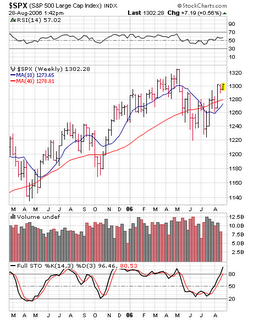It was a flat week for the stock market. That wasn't bad considering the strong gains the previous week. The comment in last week's Weekly Wrap that "the underlying tone is improving as the worst fears are fading" is still valid.
Earnings and Fed expectations dominated the action this week.
Second quarter earnings reports continued to impress. It now appears that second quarter operating earnings for the
S&P 500 companies in aggregate will post a very strong 15% gain. That is well above the 12% forecast when the reports started. There have been very few earnings warnings as well. That has led to forecasts of a similar gain in earnings for the third quarter.
The earnings trend is very impressive considering that economic growth is clearly slowing down. The growth in earnings has pushed the price/earnings multiple for the S&P 500 down to 15.2 for operating earnings (including the second quarter). The S&P 500 index has been flat for six months while earnings growth has continued. That has pushed the price/earnings multiple down and increased the relative value of stocks.
Earnings reports of note this past week included good reports from
Humana, Exelon, MetLife, Archer Daniels Midland, EDS, Emerson, International Paper, Marathon Oil, Parker-Hannifin, Verizon, Cigna, Procter & Gamble, Time Warner, CVS Corp., Sunoco, and
Tyco. A quick scan of those companies reveals that, apart from
Dow components Procter & Gamble and Sprint, there weren't many influential names. This is the time in earnings season when the companies reporting are not likely to set the tone for the whole market. The big tech and financial companies have already reported. The market has settled into its conclusion about the quarter - and it is upbeat.
Economic reports were light this week, but there was one big one. The July employment data was released on Friday. The 113,000 gain reported for
nonfarm payrolls was below expectations of a 125,000 to 150,000 increase. That led to a heightened expectation that the Fed will not raise rates at their policy meeting on Tuesday.
Fed funds futures now assume only about a 20% probability of a rate hike at the August 8 meeting.
Other economic releases this past week included moderate growth readings on both the
ISM manufacturing and ISM services indices, a smaller than expected 1.2% increase in June factory orders, an uptick in weekly new claims for unemployment to 315,000, a modest increase in July auto sales from June levels, and moderate growth in June personal income and spending. Same store sales reports for retail chains were a mixed bag, reflected moderate growth.
All in all, the economic numbers were very much consistent with a broad slowdown in economic growth, but nothing dramatic. The "soft landing" that the Fed seeks appears to be developing.
There were some slight inflation concerns. The June
core PCE deflator was up 0.2%. That in itself is not so bad, but the year-over-year gain inched higher to 2.4%. July hourly earnings in the employment report were up 0.4%. The year-over-year increase there is 3.8%. The trend in these series is slightly higher, but not severe. The Fed has expressed a willingness to wait for inflation to ease in response to slower economic growth. These data points are therefore only slightly worrisome, and are not expected to prevent the Fed from holding rates steady at this next meeting.
The
10-year note yield dipped to 4.90% this week. That reflects long-term optimism on the inflation front, and has supported the stock market. Oil closed near $75 a barrel.
The action next week will be determined not only by the Fed action on rates on Tuesday, but also by the accompanying policy statement. The stock market is now largely priced for a pause in the rate hike cycle. But a statement that reminds investors that a rate hike later this year is still possible could roil markets. The underlying tone has clearly improved, but the potential for a significant upward move is still not limited.
-- Briefing.com

















